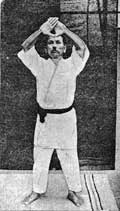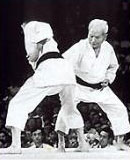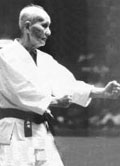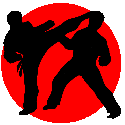THE HISTORY OF KARATE
It is believed that the oriental martial arts stem from a Buddhist monk named Bodhidharma who traveled from India to China in the 6th century B.C. He arrived in Shaolin-si ("small forest temple") and taught Zen Buddhism. He also introduced a systemised set of exercises designed to strengthen the mind and body, exercises which allegedly marked the beginning of the Shaolin style of temple boxing. Bodhidharma's teachings later became the basis for the majority of Chinese martial arts.

Inevitably, the Chinese forms of boxing (and other Asian martial arts) became known to the Okinawans, and in 1392 thirty-six families from China settled on Okinawa, most likely bringing with them a knowledge of kung fu. These fighting methods were adapted and further developed by the Okinawans and came to be known as Te (meaning "hand") or To-De (written to mean "Chinese hand" and pronounced Kara-Te in Japanese).
Over the centuries there were a number of successive weapons’ bans imposed by domestic and invading rulers between the 15th and 17th centuries. This made the Te arts much more important to the native Okinawans who not only developed and practiced their "fist based" fighting skills, but also developed a range of weapons based arts (Kobu-do) using farm implements to deadly effect. Nunchaku (flails) were horse bridles, the Bo (long staff) was used to carry water buckets, and so on. The weapons could be practiced in secret and did not arouse suspicion. These weapons are still practiced in conjunction with Karate today.
Over time different styles of Te developed. The styles were often named after the town or city where they were practiced so the Naha-Te style was based in the Naha district and focused on strong, heavy techniques, while the Shuri-Te style - from Shuri - specialised in light, fast techniques.
Two renowned experts were Ankoh Azato (1827-1906) and Ankoh Itosu (1832-1915) who practiced Naha-Te and Shuri-te respectively. These two had a student in common named Gichin Funakoshi (1868-1957) who would become known as the father of Shotokan Karate. He combined the principles of both styles in an attempt to create a system that could be practiced by all.
Gichin Funakoshi was a school teacher who was known for his skill at calligraphy and poetry. He would sign his work using his pen name Shoto ("waving pines" - these grew near his home and inspired his writing) and his style of Karate became known as Shoto Kan - Shoto's Club or School.
In 1921 he lead a demonstration of "Te" for the Crown Prince Hirohito whose approval led to invitations from various groups in Tokyo to demonstrate his art - including the Ministry of Education and the Kodokan (The Headquarters of Judo). These demonstrations lead to the establishment of many clubs in Japan’s universities, and Karate as we know it today was born!

Many Karate experts were "lost" in World War II, so in 1948 a meeting was held between some of the top karate practitioners in Japan to pool their knowledge and standardise what was being taught. This meeting resulted in the formation of the Japan Karate Association (JKA) in 1949, with Gichin Funakoshi as Chief Instructor.
Master Gichin Funakoshi died in 1957 at the age of 88, but his legacy of Karate is still practiced today.
One of Funkoshi's original students was Hironori Ohtsuka, the founder of Wado-Ryu Karate-Do.
At the age of five years old, on the advice of his Grandmother, Hironori Ohtsuka started to study the art of JuJitsu. His first lessons were from his Grandfather, Chojiro Ehashi of the Clan Tsuchiura. Under his tutiledge the young Ohtsuka learnt the arts of Tsuki, (punching), Keri (kicks), and Nagewaza (throwing).
When he was thirteen years old Ohtsuka joined the Shinto-Yoshin-Ryu School of JuJitsu, under its third Grandmaster, Shizaburo Nakayama. After entering Waseda University in Tokyo he continued to gain experience in Shinto-Yoshin-Ryu whilst also practicing with other styles of JuJitsu. Such was Ohtsuka's talents in Shinto-Yoshin-Ryu that when he visited the various Dojo (training halls) of the other JuJitsu styles, many challenges of Hon-Gumite (real fighting) were proposed. Ohtsuka gained vast experiences from these sessions, which served to rapidly increase his skills in the various techniques of JuJitsu
In June 1920, aged 29, he completed all the lessons and was awarded the license of the highest degree in Shinto-Yoshin-Ryu, which allowed him to become the 4th Grandmaster, succeeding S. Nakayama. This license proved he was a true Master and he received the award of Menkyu Kaiden.

Such was Ohtsuka's progress in Karate that after one years training with Gichin Funokoshi, he was entrusted with the title Shihan Dai, (Vice Chief Instructor). Ohtsuka's insatiable thirst for Martial Arts knowledge took him to various Dojo where he exchanged techniques with other Sensei from Okinawa, two of the most well known being, Choki Motobu, (Motobu-Ryu), and Kensei Mabuni, (Shinto-Ryu).
By 1924, Ohtsuka had developed many Yakusoko Kumite, (pre-arranged fighting techniques) he also developed Idori-No-Kata, (kneeling defence), Tachi-Ai-No-Kata and Shirahatori-No-Kata (nine defences against long sword).
At the age of 37, 1929 was to be a very important year for him. Drawing heavily upon his knowledge of JuJitsu he merged the two arts of Shinto-Yoshin-Ryu and Okinawa-Te and founded his own School Wado-Ryu Karate Jutsu and Wado Ryu Jujutsu Kenpo.
From the 1950’s on, Karate began to receive increasing international attention, mainly through exposure to American servicemen stationed in Japan after World War II, and also through Japanese students traveling abroad to study.
Karate has been practiced formally in Britain since the early 1960s, though it was Bruce Lee's film "Jing Wu Men" (better known in the West as "Fist of Fury") in 1972 that brought the oriental martial arts to prominence, and today there are martial arts schools the length and breadth of the United Kingdoms.

In November 1992, Robin Whale and a group of like-minded karate black belts resigned from Bujinkai Karate and founded the Sandokai Karate Association.
Despite competition from variant "arts" such as kick boxing, MMA (Mixed Martial Arts), XMA (Extreme Martial Arts) and Sport/ Freestyle Karate systems, Traditional Karate continues to go from strength to strength, and was an Olympic Sport in 2020.

